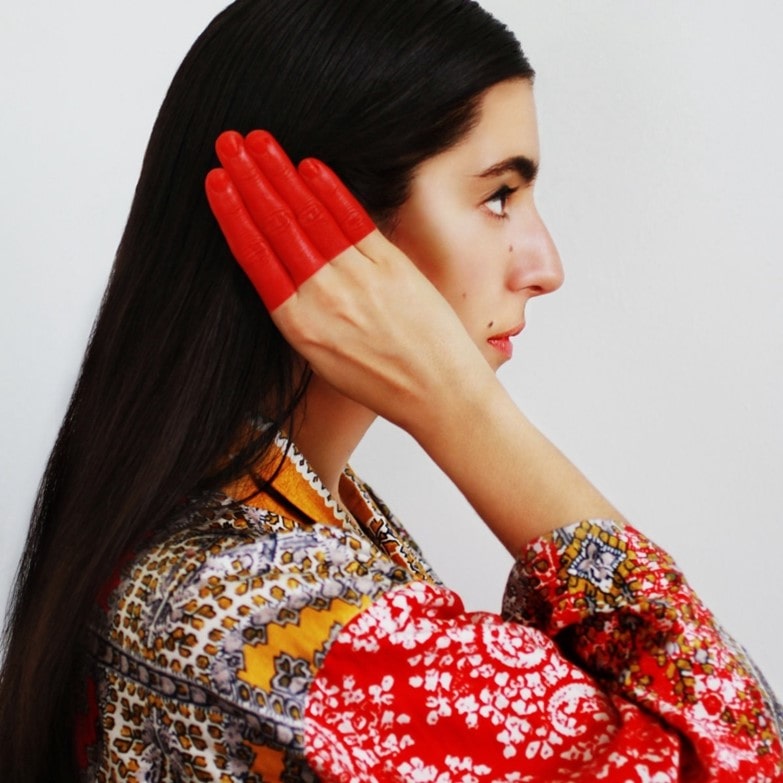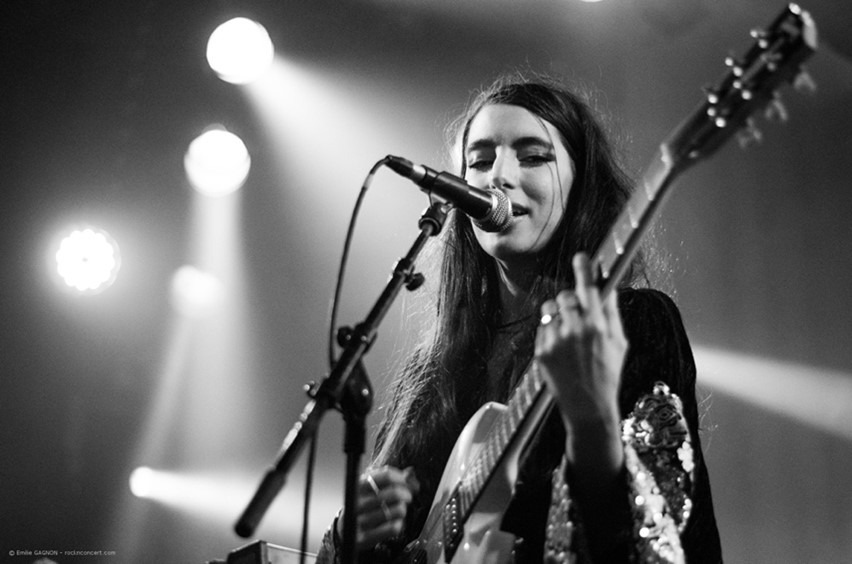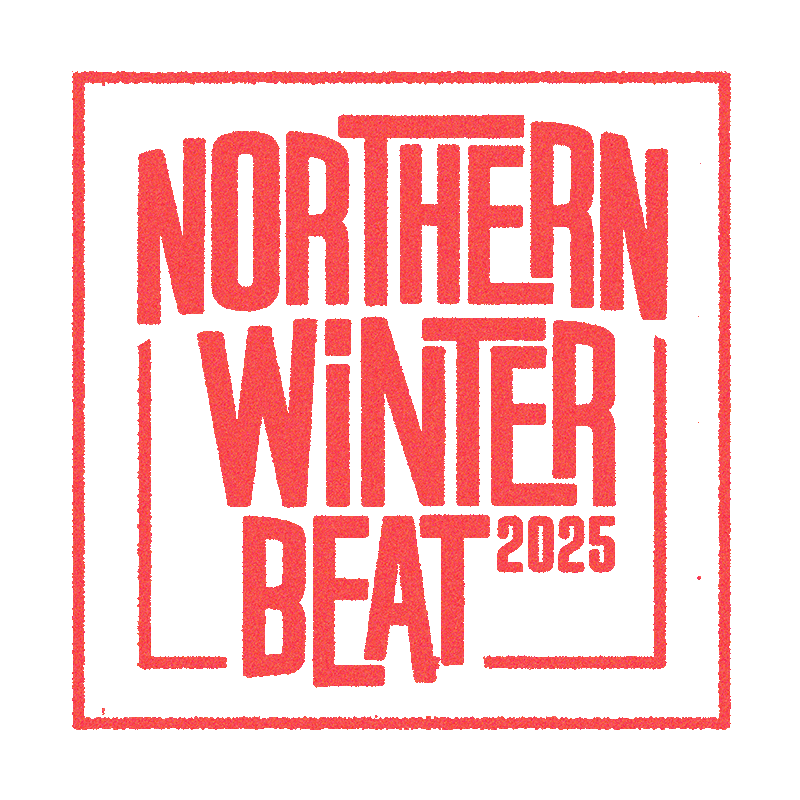NORTHERN WINTER READ:
MARIAM THE BELIEVER

Interview with Mariam Wallentin.
by Mikkel Brandt
At the 2024 edition of Northern Winter Beat, Mariam Wallentin is a part of the line-up with her solo project, Mariam the Believer. On that occasion, NWR had a Skype talk with the singer and songwriter, also known as one-half of Wildbirds & Peacedrums, and as one of the (approximately) 30 musicians on stage in Fire! Orchestra.
Mariam was sitting in her home in Bohuslän, Sweden, and before our conversation, she had just listened to the final mix of her new album for the very first time (further info and release date are yet to be announced).
I think I will start with maybe a dumb question, but I will ask it anyway… How did you find your voice?
“How I found my voice? Well, it’s not a dumb question. I grew up feeling quite lonely. I have no siblings, and I guess it’s a part of many people’s childhoods that you kind of feel isolated or want to connect, but not knowing how. So, my way of finding a kind of connection was through singing. Easy.”
Listen to Mariam The Believer – Bodylife: https://www.youtube.com/watch?v=0Hyrb4hiLH4
“We were not religious at all, but we didn’t have much money, so my mother took me to these free church gatherings when I was quite young. So we went to church once a week, and I got sandwiches, and I got to sing in this amazing room. And yeah, somehow that suited me, you know, singing to the graveyard on my way there. And it may sound pretentious, but singing for people on that graveyard kind of gave me this feeling of music as a healing, comforting power, both going inwards and outwards. I think that was my way of communicating or expressing myself.”
What kind of songs did you sing?
“I was really young then, so I don’t remember really. I think I sang anything in the beginning, just connecting with lyrics and expressing emotions that way. And having a space on stage became kind of a safe zone. ‘This is just my place.’ And I think music and art are great ways for people, for young kids, especially, to learn how to focus on ‘the now’ and use both your mind and your body. Then, when I got a bit older, being in my young teens, I had a teacher who introduced me to jazz, and I got ‘The Real Book’, the standard classical thing. That was really an eye-opener for me because it was like, ‘Wow, I can sing songs, but I can still be free in them, and search.’”
Were you also creating songs on your own?
“Yes, yes. I started writing, or making up songs, quite early as well. As a child, I lived with my aunt for a while, and I remember making up songs with my cousins on the swing.”
Listen to Mariam The Believer – Somewhere Else: https://www.youtube.com/watch?v=t_dIeGGyigg
Do you remember the first time you thought, “Oh, I’m a performer now,” or noticed the difference between performing for people in a room in contrast to just singing for yourself?
“I don’t think I remember the first time I thought about it. And I still don’t know if I think of it. I mean, it’s still a challenging thing sometimes to have people look at you or receive applause. I’m still not super comfortable with that. I still prefer just to sing. But maybe my first memory of this was when I performed at this talent show, or whatever you call it. My mother had signed me up, and I was maybe 11 or 12 or something. It was summer, and I sang this really cheesy but also beautiful song. It’s in Swedish, and the refrain goes something like, ‘Love me, love me for who I am.’ I did a solely version of it, and I’m not sure if the memory is fabricated now, but that made me realize that, ‘Oh, I can actually let out emotions on stage, and people can receive them.’ It’s still something I try to balance. Like, ‘Okay, how personal can I be in my emotions and still be inviting?’ So other people can, if they want to, take it with them.”
Yeah, and it must also be quite different to sing with, let’s say, Fire! Orchestra, compared to standing alone on stage singing a cappella?
“Yeah, and I’m not sure what’s most vulnerable. It’s different.”
Listen to Fire! Orchestra – Enter: https://www.youtube.com/watch?v=-K_RJHOArRo
When did you start to think about the more technical sides?
“In my voice? I don’t know if I’ve ever thought much about it. Unfortunately, I’m not very trained. In one way, I am because I’m constantly searching somehow, trying to use my instrument in nuanced, interesting, or new ways. But I’m not very technical. I mean, I still write all my songs on the piano, but in one way, I don’t know chords. I’ve ignored that somehow. I remember realizing when I was in my 20s, or late teens, that my body is my instrument and understanding, that how I take care of my body, or how I stand, or how I move is also affecting my instrument.”
How is your approach when you go into the studio compared to when you stand on stage?
“I’ve always loved not being too filtered when I’m in the studio. When I listen back to records I made 10 years ago, our first Wildbirds & Peacedrums album, or something like that, I kind of still remember that feeling of trying not to be perfect. Because I’m really bad at trying to be perfect. Other people can sing perfectly clear and still carry the emotions along, but it’s not for me. So it’s a balance. I love working with that in the studio. To try to be direct, just as if I was standing in front of a crowd. So the take is alive, and there’s some rawness left to it. I also love taking live takes. I mean, just one take.”
Do you spend much of time with the takes afterwards, listening back?
“No.”
You’re working quite intuitively?
“Quite intuitively, yeah. Just before our talk, I actually listened to the final mix of my coming album, and it’s actually done. So we can celebrate now.”
Congratulations! Am I the first person you talk to after listening to it?
“Yes. You actually are.”
What an honour. Cheers!
“Cheers! But yeah, that was a really long process for me. I mean, I love quite fast, intuitive processes. But then, of course, as you make more albums, you want to try something new with it, and da-da-da. When we recorded the instruments, I hadn’t quite finished all the lyrics. So I needed to do the vocals on top afterwards, but I still wanted to create an intimate room and capture it quite live, with just some overdubs afterwards. We did the vocals in a friend’s barn, which is also a little studio. He has a barn that he rebuilt as a dance studio, which we are now rebuilding as a studio.”
Will you bring some of the new music to Northern Winter Beat?
“Yes, we will. Because this one has taken a bit longer due to babies and stuff, we actually have played quite a lot of the material for a couple of shows now.”
Can you describe your live setup?
“Yeah, it’s kind of a modern chamber setup somehow, with two string players on viola da gamba, cello and viola, and there’s grand piano, keyboards and percussion. So quite minimalistic, but still big.”
Viola da gamba?
“It’s a string instrument. You can google it. I don’t dare to talk about it too much except that it’s a Baroque instrument. So you need to check that out. But it has a different timbre, roar, somehow.”
Who’s with you on stage?
“There’s a string player that I’ve worked with quite a lot. Her name is Josefin Runsteen. She also plays a bit in Fire! Orchestra now, and with Trondheim Jazz Orchestra and stuff. Then there’s her brother on viola da gamba, who’s more classical-orientated. He’s amazing. He plays quite a lot of Baroque music, but he’s also in The Gothenburg Symphony Orchestra. And Andreas, my husband, the Wildbirds drummer (and Tonbruket, Ghosted, etc.), on percussion. And then an improv jazz piano player, who’s amazing, called Johan Graden, who also has this jazz project with Ellen Arkbro. And Alex Zethson, who’s also a brilliant improviser and runs a record label (Thanatosis), on keyboards.”
Will there be a lot of improvisation on stage?
“Yes, I think I’ve always wanted to incorporate that. Even when playing with my pop projects. I love that balance. I mean, I love songs, pure songs somehow, but I like to make them come alive. So we’re incorporating both approaches.”
Another thing I’m a bit curious about is how the themes in the lyrics affect the way they are sung and vice versa.
“The balance of the words, lyrics and music?”
Yeah, how’s that process?
“I think in a creative process, when I’m in a writing mode, I often try to start on a phrase, a lyrical phrase, to get inspiration. I’m not sure if I did that with this album, though, but normally I’m quite visceral when I write. I like to imagine a room where I write from. It can be something simple. It can be something structural. Like, ‘Okay, there’s a quite rough or dry surface. There’s no water, it’s dusty. Is it dark, or is it light?’ It can be big landscapes, but it can also be something physical. Yeah, so I’m just trying to find my way in it.”

“I’ve never been really great at, or interested in, writing a story from A to B. But I try to find a place where I think, ‘Okay, this is the core of the song.’ Like a father leaving a child or whatever… I just make something up now. When that room is made, then I think it’s interesting to find out, ‘Okay, where am I looking from in the room? Am I a little fly on the roof looking down, or am I this big body sitting on a chair in the room?’ Using different perspectives to describe big emotional waves while still looking at the small things. Like the coffee cup that’s half cold and empty, that he left on the table.”
So these perspectives affect the details and words you are using?
“Yes, and also the details in the music. Then it’s like, ‘Okay, is it big emotions for the whole refrain?’ You know, big words, ‘love,’ or blah-blah, or something. Allmänt mänskligt. Maybe then the music needs to be balanced with a small sound that’s continuous, or a little line, you know. I love that. I could talk about this the whole day.”
Listen to Pet Sounds Presents #1: Mariam The Believer – All There Is And More: https://www.youtube.com/watch?v=Nxk-kUHTyHY
“For the last five years or so, I’ve kind of realized that it’s a part of how I need to and want to create. I’m lucky to be able to do that. To be able to express many sides of myself because I think we’re all really complex as human beings. I mean, we all know an aggressive, grumpy old man sitting and drinking a beer in a restaurant. If you understand what I mean. Maybe he also had a wife that he lost and kissed her on her cheek. He also has that side.”
To end this conversation, I would like you to pick a song we can put in the article and talk about a bit. It can be anything.
“The first thing that comes to mind is, ‘Okay, what did I release last?’ It was quite many years ago. But maybe ‘Love Makes Us Better’ from 2019. Yeah. There’s a really nice video of it where we play it live on a boat.”
How did you approach that song?
“I wrote it on the day of the Swedish election in the autumn of 2018. I wrote it in just one hour or two. I don’t do that a lot, that fast and both melody and lyrics at once. It was a very emotional process writing it. I thought about the future and how we take care of each other. Now, it’s kind of becoming mainstream over here, but that was really an important election because the racist party in Sweden got a lot of votes. So I was really worried about that. That’s why I wrote it. I realized I wanted to have strings on it because I hadn’t worked with that a lot before with Mariam the Believer. I had a few shows coming up, so I put together a string quartet, brought keys and percussion as well, and asked Josefin to help me make the string arrangements on top. So we did that, and we played some shows, and then we released that ‘String Variations EP’. ‘Love Makes Us Better’ was the new, and then we did live versions of older songs.”
How did you find the voice for that song?
“I think I wanted something clear. I knew I wanted to make it into, not a ballad, but rather this kind of mid-ballad. So it’s kind of a ballad, but it’s not a poppy, poppy song. I knew I wanted to have a steady, calm pace but not too saucy. And I wanted to have kind of a desperation or a need in it. Some people may listen to it as a love song. It is a love song, but for me, it wasn’t directed to just one specific person. It was meant as kind of a wake-up call somehow, as just a human being in life being very small and not feeling that I can affect so much. It was just my way of saying, ‘Hello, when loving, you become a better person. So try to do that a bit more often. Can’t we?’ Yeah.”
We’ll put a link to the song in the article. And thanks a lot for taking the time to talk. I’m looking forward to hearing you in Aalborg!
“Yeah, I’m excited too. It will be our first show of the year, and what a good way to start it.”
And congratulations on the album again!
“Yeah, thank you. Great talking to you. I will celebrate with another cup of coffee.”
Experience Mariam The Believer at Northern Winter Beat 2024 February 2nd.

